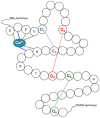Zonulopathies as Genetic Disorders of the Extracellular Matrix
- PMID: 39766898
- PMCID: PMC11675282
- DOI: 10.3390/genes15121632
Zonulopathies as Genetic Disorders of the Extracellular Matrix
Abstract
The zonular fibres are formed primarily of fibrillin-1, a large extracellular matrix (ECM) glycoprotein, and also contain other constituents such as LTBP-2, ADAMTSL6, MFAP-2 and EMILIN-1, amongst others. They are critical for sight, holding the crystalline lens in place and being necessary for accommodation. Zonulopathies refer to conditions in which there is a lack or disruption of zonular support to the lens and may clinically be manifested as ectopia lens (EL)-defined as subluxation of the lens outside of the pupillary plane or frank displacement (dislocation) into the vitreous or anterior segment. Genes implicated in EL include those intimately involved in the formation and function of these glycoproteins as well as other genes involved in the extracellular matrix (ECM). As such, genetic pathogenic variants causing EL are primarily disorders of the ECM, causing zonular weakness by (1) directly affecting the protein components of the zonule, (2) affecting proteins involved in the regulation of zonular formation and (3) causing the dysregulation of ECM components leading to progressive zonular weakness. Herein, we discuss the clinical manifestations of zonulopathy and the underlying pathogenetic mechanisms.
Keywords: Marfan syndrome; ciliary zonule; ectopia lentis; zonulopathy.
Conflict of interest statement
The authors declare no conflict of interest.
Figures




Similar articles
-
Targeted deletion of fibrillin-1 in the mouse eye results in ectopia lentis and other ocular phenotypes associated with Marfan syndrome.Dis Model Mech. 2019 Jan 25;12(1):dmm037283. doi: 10.1242/dmm.037283. Dis Model Mech. 2019. PMID: 30642872 Free PMC article.
-
The mgΔlpn mouse model for Marfan syndrome recapitulates the ocular phenotypes of the disease.Exp Eye Res. 2021 Mar;204:108461. doi: 10.1016/j.exer.2021.108461. Epub 2021 Jan 28. Exp Eye Res. 2021. PMID: 33516761
-
Zinn's zonule.Prog Retin Eye Res. 2021 May;82:100902. doi: 10.1016/j.preteyeres.2020.100902. Epub 2020 Sep 25. Prog Retin Eye Res. 2021. PMID: 32980533 Free PMC article. Review.
-
Loss of ciliary zonule protein hydroxylation and lens stability as a predicted consequence of biallelic ASPH variation.Ophthalmic Genet. 2019 Feb;40(1):12-16. doi: 10.1080/13816810.2018.1561904. Epub 2019 Jan 2. Ophthalmic Genet. 2019. PMID: 30600741
-
Zonulopathy and Its Relation to Primary Angle Closure Disease: A Review.J Glaucoma. 2024 Dec 1;33(12):931-939. doi: 10.1097/IJG.0000000000002385. Epub 2024 Apr 5. J Glaucoma. 2024. PMID: 38573908 Review.
References
Publication types
MeSH terms
Substances
LinkOut - more resources
Full Text Sources
Research Materials
Miscellaneous

